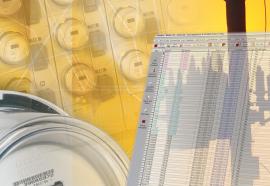Advanced metering infrastructure
Crossing the Threshold
Technology opens customers’ homes to utility services.
Advanced metering infrastructure and intelligent appliances are opening the door to a new market for utility services. But in-home services are a completely different ball game. Going beyond the meter will require utilities to transform the way they engage and serve customers.
Bringing Customers On Board
Realizing the benefits of smart meters.
Information is power, and through smart technologies utility customers will gain access to that information. The challenge faced by utilities is to harness consumer benefits by boosting customer acceptance and participation in programs designed to lower system expenses.
Smart Metering: TOU Billing Today
The best example of combined dynamic rates and smart billing is found in Ontario, Canada. It uses central MDM to produce time-differentiated customer bills.
Lies, Damn Lies, and Statistics
How does the DuPont Model—a hybrid of which provides the methodology behind the Fortnightly 40 rankings—actually work? The author shares lessons learned during implementation of the hybrid model this year.
(September 2006) How does the DuPont Model—a hybrid of which provides the methodology behind the Fortnightly 40 rankings—actually work? The author shares lessons learned during implementation of the hybrid model this year.
Letters to the Editor
David Powell, Southeast Lineman Training Center: I enjoyed reading “Baby Boom Blues”. What amazes me is although there is a great need it seems the only people who see the need are the utility companies themselves.
David Sumner, CEO, ARRL: Even the “cloudy” outlook for BPL reported in your article &ldquoA Hard Look at BPL: Utilities Speak Out” is overly optimistic.
AMI/Demand Response: Getting It Right the First Time
Each DR portfolio will have a different set of AMI needs, based on overall technology infrastructure.
Advanced metering infrastructure (AMI) evaluations will benefit greatly from creating an appropriate DR portfolio as part of the overall solution.
In the Energy Policy Act of 2005 (EPACT), Congress sent a strong message to electric utilities, consumers, and industry regulators that they need to get serious about advanced metering, time-based rates, and demand response (DR).
To underline this point, EPACT states:







